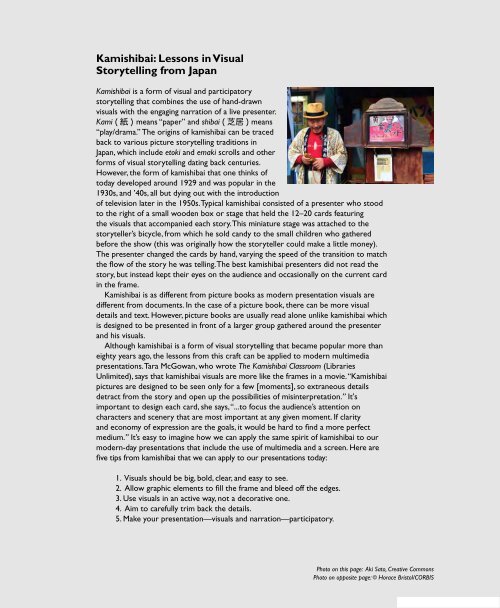Making-Original-Products-presentationzen
Create successful ePaper yourself
Turn your PDF publications into a flip-book with our unique Google optimized e-Paper software.
Kamishibai: Lessons in Visual<br />
Storytelling from Japan<br />
Kamishibai is a form of visual and participatory<br />
storytelling that combines the use of hand-drawn<br />
visuals with the engaging narration of a live presenter.<br />
Kami ( 紙 ) means “paper” and shibai ( 芝 居 ) means<br />
“play/drama.” The origins of kamishibai can be traced<br />
back to various picture storytelling traditions in<br />
Japan, which include etoki and emaki scrolls and other<br />
forms of visual storytelling dating back centuries.<br />
However, the form of kamishibai that one thinks of<br />
today developed around 1929 and was popular in the<br />
1930s, and ’40s, all but dying out with the introduction<br />
of television later in the 1950s. Typical kamishibai consisted of a presenter who stood<br />
to the right of a small wooden box or stage that held the 12–20 cards featuring<br />
the visuals that accompanied each story. This miniature stage was attached to the<br />
storyteller’s bicycle, from which he sold candy to the small children who gathered<br />
before the show (this was originally how the storyteller could make a little money).<br />
The presenter changed the cards by hand, varying the speed of the transition to match<br />
the flow of the story he was telling. The best kamishibai presenters did not read the<br />
story, but instead kept their eyes on the audience and occasionally on the current card<br />
in the frame.<br />
Kamishibai is as different from picture books as modern presentation visuals are<br />
different from documents. In the case of a picture book, there can be more visual<br />
details and text. However, picture books are usually read alone unlike kamishibai which<br />
is designed to be presented in front of a larger group gathered around the presenter<br />
and his visuals.<br />
Although kamishibai is a form of visual storytelling that became popular more than<br />
eighty years ago, the lessons from this craft can be applied to modern multimedia<br />
presentations. Tara McGowan, who wrote The Kamishibai Classroom (Libraries<br />
Unlimited), says that kamishibai visuals are more like the frames in a movie. “Kamishibai<br />
pictures are designed to be seen only for a few [moments], so extraneous details<br />
detract from the story and open up the possibilities of misinterpretation.” It's<br />
important to design each card, she says, “...to focus the audience’s attention on<br />
characters and scenery that are most important at any given moment. If clarity<br />
and economy of expression are the goals, it would be hard to find a more perfect<br />
medium.” It’s easy to imagine how we can apply the same spirit of kamishibai to our<br />
modern-day presentations that include the use of multimedia and a screen. Here are<br />
five tips from kamishibai that we can apply to our presentations today:<br />
1. Visuals should be big, bold, clear, and easy to see.<br />
2. Allow graphic elements to fill the frame and bleed off the edges.<br />
3. Use visuals in an active way, not a decorative one.<br />
4. Aim to carefully trim back the details.<br />
5. Make your presentation—visuals and narration—participatory.<br />
Photo on this page: Aki Sato, Creative Commons<br />
Photo on opposite page: © Horace Bristol/CORBIS



